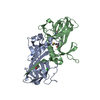+Search query
-Structure paper
| Title | Structure and transformation of bacteriophage A511 baseplate and tail upon infection of cells. |
|---|---|
| Journal, issue, pages | EMBO J, Vol. 38, Issue 3, Year 2019 |
| Publish date | Feb 1, 2019 |
 Authors Authors | Ricardo C Guerrero-Ferreira / Mario Hupfeld / Sergey Nazarov / Nicholas Mi Taylor / Mikhail M Shneider / Jagan M Obbineni / Martin J Loessner / Takashi Ishikawa / Jochen Klumpp / Petr G Leiman /    |
| PubMed Abstract | Contractile injection systems (bacteriophage tails, type VI secretions system, R-type pyocins, etc.) utilize a rigid tube/contractile sheath assembly for breaching the envelope of bacterial and ...Contractile injection systems (bacteriophage tails, type VI secretions system, R-type pyocins, etc.) utilize a rigid tube/contractile sheath assembly for breaching the envelope of bacterial and eukaryotic cells. Among contractile injection systems, bacteriophages that infect Gram-positive bacteria represent the least understood members. Here, we describe the structure of bacteriophage A511 tail in its pre- and post-host attachment states (extended and contracted, respectively) using cryo-electron microscopy, cryo-electron tomography, and X-ray crystallography. We show that the structure of the tube-baseplate complex of A511 is similar to that of phage T4, but the A511 baseplate is decorated with different receptor-binding proteins, which undergo a large structural transformation upon host attachment and switch the symmetry of the baseplate-tail fiber assembly from threefold to sixfold. For the first time under native conditions, we show that contraction of the phage tail sheath assembly starts at the baseplate and propagates through the sheath in a domino-like motion. |
 External links External links |  EMBO J / EMBO J /  PubMed:30606715 / PubMed:30606715 /  PubMed Central PubMed Central |
| Methods | EM (single particle) / X-ray diffraction |
| Resolution | 2.38 - 16.0 Å |
| Structure data |  EMDB-7559:  EMDB-7560:  EMDB-7561:  PDB-6hhk: |
| Chemicals |  ChemComp-CL:  ChemComp-HOH: |
| Source |
|
 Keywords Keywords | VIRAL PROTEIN / bacteriophage baseplate protein |
 Movie
Movie Controller
Controller Structure viewers
Structure viewers About Yorodumi Papers
About Yorodumi Papers



 listeria phage a511 (virus)
listeria phage a511 (virus)